
PEUGEOT 306
Generations Timeline, Specs and Pictures
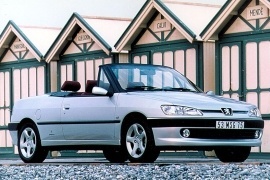
The Peugeot 306 underwent some serious modifications in 1997, with the new model being developed as the Phase II 306.
The bodywork featured more roundish lines, including the front bumper, grille and headlights-design. As compared to the previous generation 306 Coupe Cabrio, the new model was offered with a choice of 4 engines, including a new 1.8L 16 valves unit (with the 2.0L unit also gaining 16 valves for 1997). The car featured several interior changes in 1998, including a different center console and a restyled steering wheel. The model was discontinued in 2003.

Along with the facelifted version of the 306 range, Peugeot also introduced a new body version for its small-segment contender: the station wagon.
The 306 ranked in the top ten best-selling vehicles in the UK since 1994, so the refreshed version should keep those selling figures up. It did, but only until the end of 1998. One of its problems was the trunk space, and that’s why Peugeot tried to fix that with a station wagon version.
The facelifted version featured different headlights, with rounded edges and an angry look that matched the front fascia of the successful Peugeot 406. The raked windshield and the clean, rounded lines were a step forward from its predecessor. Peugeot introduced a new bumper with a “smiley face” lower grille and encased fog lights. Behind the rear doors, which were identical to those installed on the five-door hatchback and the sedan, the carmaker installed a wide window. Thanks to the darkened D-pillars, the carmaker created the image of a wrapped-around glass area. At the back, the tailgate was flanked by new taillights with a vertical, rounded shape.
Inside, the designers sweetened the lines with rounded edges instead of angular lines. On the center stack, Peugeot installed the HVAC controls and the audio system. It didn’t seem like its designer broke a sweat to make a completely new design. The car’s most significant advantage was the 442 liters (15.6 cu-ft) trunk space. With the rear seats folded down, that volume increased to an astonishing 1,512 liters (53.4 cu-ft).
There was a choice of seven engines available under the hood: five were with gasoline, and three were diesel. Depending on the trim level and powerplant, the carmaker offered a five-speed manual transmission as standard or a four-speed automatic.
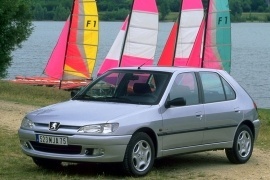
The compact hatchback from Peugeot stepped back with its numbering system and named the 306 after the 309, and it introduced it in 1993.
Three years later, it received its first facelift for the entire range.
Peugeot 306 was a simple, compact French car, built to cope with everyday tasks around town. It was fitted with economical engines, and it was affordable. It was good for young families and offered enough interior room for up to five passengers for short distances. For long trips, it was good only for four.
The facelifted version featured different headlights, with rounded edges and an angry look. The raked windshield and the clean, rounded lines were a step forward from its predecessor. A new bumper with a “smiley face” lower grille and encased fog-lights was introduced. Unlike the 3-door version, the front doors were shorter to leave enough room for the rear ones.
Inside, the lines were sweetened with rounded edges instead of clear cuts. On the center stack, Peugeot installed the HVAC controls and the audio system. It didn’t seem like its designer broke a sweat to make a completely new design.
There was a choice of eight engines available under the hood: five were with gasoline, and three were diesel. The most spirited one, the GTI, offered 135 hp, and it was mated to a six-speed gearbox. It was unusual for those times to see an affordable, compact-sized vehicle with that kind of transmission.
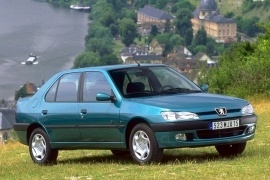
Arguably Peugeot’s leading export model at the time, having been allegedly shipped to over 130 countries, the 306 sedan successfully filled the void of the French maker’s back-then line-up.
Designed to compete in the high end small car segment, the 306 sedan came with a naturally aspirated 4 cylinder 1.8-liter engine that could make it from 0 to 60 in a sluggish 14.3 seconds. It may not have been powerful but it had its strengths. Unlike the hatchbacks built in 1994 when most of the 306 models entered production, the car was awarded with a 4 out of 5 stars for front occupant safety rating during EuroNCAP tests.
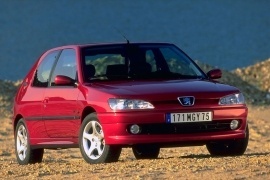
The compact hatchback from Peugeot stepped back with its numbering system and named the 306 after the 309.
It was launched in 1993 and in 1996 it received its first facelift for the whole range.
Peugeot 306 was a simple compact French car, built to cope with everyday tasks around town. It was fitted with economical engines and it was affordable. On the other hand, the three-door version was used in two opposite directions. One for the delivery teams and one for those who needed a sportier and affordable compact car. It was cheaper than the Golf and more spirited than other competitors.
The three-door version was available with the same engine choices as the five-door, except for the top of the range GTI. It was also offered in a “Rally” special edition, which was lighter and more agile. The 1996 model featured a redesigned front grille, headlights, and bumpers. The taillights were visually enhanced as well.
Inside, the same plain dashboard as in any other 306, but with a new design for the instrument cluster on the GTI version. In France, a commercial version with seats only in the front was available, but it kept the side windows in place.
Under the hood, there was a choice of eight engines available: five were with gasoline and three were diesel. The most spirited one, the GTI, offered 135 hp and it was mated to a six-speed gearbox. It was unusual for those times to see an affordable, compact-sized vehicle with that kind of transmission. But it was the base for race-cars. It won on rallies and on endurance races.

The French compact-class vehicle was one of the best-sellers in Europe and for a good reason.
In its entire lifespan between 1993 and 2002 it was sold in nearly 3 million units. In 1997, the car went through a major facelift, which affected the design, engines, and interior.
The 306 GTI-6 was the top of the line trim and featured bucket seats, white dials for the tachometer and speedometer, a sporty steering-wheel and an enhanced suspension. Also, it had more safety features than other versions of the 306.
The base platform was kept the same, but the bumpers, headlights, and taillights were changed. One of the most noticeable changes was the introduction of the turn-signal indicators inside the headlights, instead of the outside location onto a different lamp. Light-alloy wheels were offered as standard on the higher trim levels and more powerful engines, like on the 306 Gti-6 version. It was the sportiest version of them all, and it was considered the true replacement for the older Peugeot 205 GTI, a rally-legend in its era.
The power came from a 2.0-liter naturally aspirated engine with four cylinders. The introduction of a twin-cam with 16 valves (DOHC system) led to 164 hp, which was a lot for that era. The 306 GTI-6 was the base model for the rally version 306-Maxi for the F2 category, which paved the way for the World Rally Championship title.
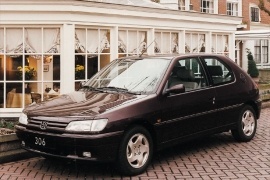
This small family car was released as a replacement for the Peugeot 309.
Having shared the same platform as the Citron ZX as part of a mother-company policy set from its beginnings, the 306 was built in various body stiles until it ended production in 2002 when it made way for the much improved 307; one could have chosen between the 3 and 5 door hatchbacks, go for the larger sedan or estate versions or pick the sportier coupe. Four cylinder petrol engines with displacements ranging from 1.1 to 1.6 L were used first until the small 1.1 was dropped in favor of the 1.4 and 1.6, the latter having been the best quality/economy choice.
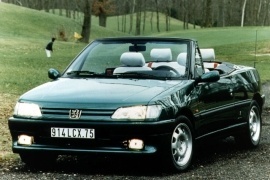
In 1993, Peugeot introduced the 306 range that replaced the 309 lineup and, in the following year, it revealed the open-top version.
Like its predecessor, the 306 was often compared to the 205 model, which was a legend for the French carmaker. Peugeot tried to make things better and, since the 205 was available in a rag-top version, it created a convertible version for the 306 as well.
With the open-top version, the 306 lineup was complete. The compact vehicle was available as a 3- and 5-door hatchback, a sedan, a station wagon, and a cabriolet. At the front, it featured the new design language of the French Lion, with angled headlights and a pair of narrow cuts in the grille. Pininfarina designed the convertible and offered reasonable solutions to conceive the retractable fabric roof between the rear seats and the trunk. It managed to develop the car without the need of a B-pillar or a visible safety arch.
Inside, the design team put together a varied range of colors and materials better suited to be exposed to direct sunlight. The dashboard featured an angular-looking center stack with the audio controls and the ventilation system easy to reach. Its high-bolstered seats offered good lateral support, but there was little legroom for the rear passengers.
Peugeot installed a choice of three engines under the 306’s hood. All of them were paired as standard to a 5-speed manual, while a 4-speed automatic was on the options list.

Peugeot introduced the 306 in 1993 as a replacement for the nine-year-old 309 and was built on the same platform as the Citroen ZX.
At the beginning of the ’90s, the hatchback market was on an ascending trend, and the French carmaker was good at it. After the 306 experience, Peugeot understood that the era of big, expensive, curved rear windows was gone and changed the entire concept. That led to a more dynamic look of its vehicles and marked a step away from the overall domestic look.
There was a new design language for the French carmaker, who suddenly remembered that its badge was a lion and put the feline-eye-shaped headlights on the car. It looked miles away from most of its competitors who insisted on squared or round headlamps. The hood left a small gap underneath, above the bumper, for the grille. Its raked-forward tailgate was another important improvement since it didn’t feature an additional tail behind the rear window. It was a proper two-box hatchback.
Inside, the carmaker understood the importance of a center stack and built the dashboard with that center element incorporated under the same roof as the instrument panel. All the controls from it were easier to reach by the driver. Moreover, Peugeot understood that the radio controls are more important than the climate controls and placed the cassette player above them. The front seats were comfort-oriented, while the bench was suitable for three children or two adults, as long as the front occupants were not too tall.
Under the hood, Peugeot installed a wide engine choice ranged between 60 hp and 155 hp. The latter was more potent than the acclaimed VW Golf GTI.























































